All of my opinions are italicized and sources are in blue.
As reported by Ars Technica,
Eric Migicovsky, co-founder of the all-in-one messaging service Beeper, says Beeper Mini (which should be available now) can do this because iMessage has been reverse-engineered. In an interview, Migicovsky said that Beeper was contacted last summer by a security researcher, one who had a Python script proof-of-concept repository to prove his discovery. The Beeper team was initially hesitant, having “talked to every person on Earth, it seems, who said they’d cracked it, but really only partially reversed [iMessage].”
But the script worked, so Beeper hired the researcher and, over the last three months, completely rewrote their client into this new Mini app. It’s offered as a seven-day free trial, then costs $2 per month.
It may or may not surprise you to learn that the security researcher is a high school student. “We couldn’t convince him to drop out,” Migicovsky messaged, adding a smile emoji.
Beeper Mini is launching less than a month after Nothing and Sunbird made headlines for promising iMessage on Android, then unraveling at lightning speed as the scheme was revealed to be “a security catastrophe.” So Beeper has written up how iMessage and the company’s app work and interact on its blog, and offered a bunch of pledges up front:
- Messages are end-to-end encrypted before sending, and neither Beeper nor Apple can see them
- The encryption keys necessary for iMessage do not leave your device
- No server sits between Beeper Mini and iMessage servers
- Your Apple ID is not required
- Your contact list remains on your device
At the moment, Beeper Mini supports group chats, high-resolution images and video and voice messages, stickers and GIFs, reply threads, and sent/delivered/read/typing status. Location-sharing, message effects (like confetti falling), Facetime, and iMessage-based games are not yet supported (and the games likely never will be).
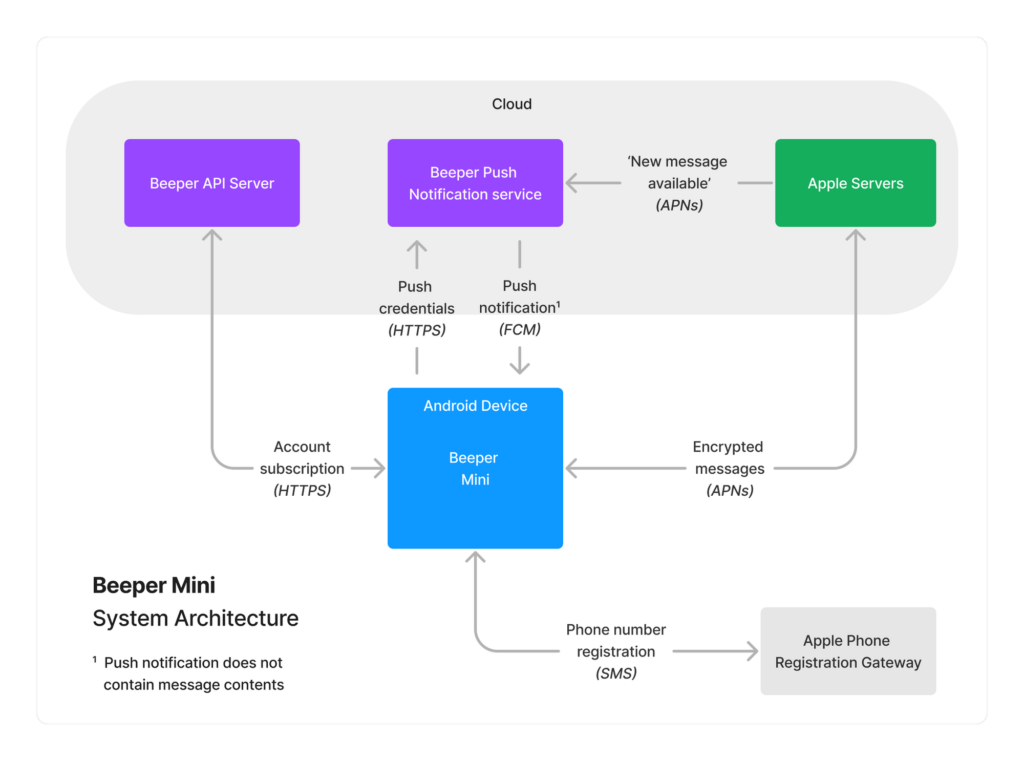
How Beeper Mini works
If you want to know exactly how iMessage could be used without an Apple device initiating a connection, Beeper’s blog post explains it, and JJTech’s blog post explains it even more. A brief version is that Beeper Mini sends an SMS message from your phone to “Apple’s ‘Gateway’ service,” which sends back an SMS, and data from that SMS is then sent back again to register your phone number with Apple as iMessage-capable. The app then generates encryption keys to encrypt your messages with others, sending the public key to Apple servers and stashing the private key on your local storage.
That’s the setup, anyway. To keep Beeper Mini running, Beeper uses a Beeper Push Notification (BPN) service to connect to Apple’s servers and notify you of new messages. That doesn’t mean Beeper sends and receives your messages, however; the Apple Push Notification (APN) service separates its notification credentials from its content encryption keys, according to Beeper. “BPN can only tell when a new message is waiting for you—it does not have credentials to see or do anything else,” Beeper’s post states.
A user with an Android phone can use Beeper Mini without an Apple ID and still send and receive encrypted iMessages. If you have a MacBook or iPad that you want your messages to show up on, too, you’ll need to sign in to your Apple ID in Beeper Mini. Beeper notes that it sends those to Apple over an encrypted HTTPS request.
A few days after the team at Beeper proudly announced a way for users to send blue-bubble iMessages directly from their Android devices without any weird relay servers, and about 24 hours after it became clear Apple had taken steps to shut that down, Apple has shared its take on the issue.
The company’s stance here is fairly predictable: it says it’s simply trying to do right by users, and protect the privacy and security of their iMessages. “We took steps to protect our users by blocking techniques that exploit fake credentials in order to gain access to iMessage,” Apple senior PR manager Nadine Haija said in a statement.
Here’s the statement in full:
At Apple, we build our products and services with industry-leading privacy and security technologies designed to give users control of their data and keep personal information safe. We took steps to protect our users by blocking techniques that exploit fake credentials in order to gain access to iMessage. These techniques posed significant risks to user security and privacy, including the potential for metadata exposure and enabling unwanted messages, spam, and phishing attacks. We will continue to make updates in the future to protect our users.
But, because Bepper Mini uses Apple servers, Bepper Mini is still more secure than using SMS. Trying to take down Bepper will hurt the privacy of Android users and iPhone users, because you can’t expect everyone to “buy their mom an iPhone”, looking at you Tim Cook.
As reported by Ars Technica,
Google is dealing with its second “lost data” fiasco in the past few months. This time, it’s Google Drive, which has been mysteriously losing files for some people. Google acknowledged the issue on November 27, and a week later, it posted what it called a fix.
It doesn’t feel like Google is describing this issue correctly; the company still calls it a “syncing issue” with the Drive desktop app versions 84.0.0.0 through 84.0.4.0. Syncing problems would only mean files don’t make it to or from the cloud, and that doesn’t explain why people are completely losing files. In the most popular issue thread on the Google Drive Community forums, several users describe spreadsheets and documents going missing, which all would have been created and saved in the web interface, not the desktop app, and it’s hard to see how the desktop app could affect that. Many users peg “May 2023” as the time documents stopped saving. Some say they’ve never used the desktop app.
Drive has multiple ways of syncing files, which complicates any explanation or diagnosis of what’s going on. The most suspect mode in the whole fiasco is the default “file streaming,” mode which is actually cloud-first. Files get removed from your computer and stored in the cloud, saving space and leaving only a web link in their place. Perhaps a “syncing” issue could remove files from your computer before uploading (that still doesn’t explain the claims of missing web documents, though).
Google still hasn’t explained what exactly happened or how it’s been fixed, but just reading through these instructions makes the issue sound rather complicated. This isn’t just a simple case of fixing this “syncing” issue by shipping a new version and having everyone’s files reappear.
Google’s recovery instructions outline a few ways to attempt to “recover your files.” One is via a new secret UI in the Google Drive desktop app version 85.0.13.0 or higher. If you hold shift while clicking on the Drive system tray/menu bar icon, you’ll get a special debug UI with an option to “Recover from backups.” Google says, “Once recovery is complete, you’ll see a new folder on your desktop with the unsynced files named Google Drive Recovery.” Google doesn’t explain what this does or how it works.
Option No. 2 is surprising: use of the command line to recover files. The new Drive binary comes with flags for ‘–recover_from_account_backups’ and ‘–recover_from_app_data_path’, which tells us a bit about what is going on. When Google first acknowledged the issue, it warned users not to delete or move Drive’s app data folder. These flags from the recovery process make it sound like Google hopes your missing files will be in the Drive cache somewhere. Google also suggests trying Windows Backup or macOS Time Machine to find your files.
Google locked the issue thread on the Drive Community Forums at 170 replies before it was clear the problem was solved. It’s also marking any additional threads as “duplicates” and locking them. Taking away the space to diagnose the issue and communicate fixes adds to the sense that Google is more interested in PR damage control than helping users. It also doesn’t allow people to reply to the “solution” post, so it’s hard to evaluate the fix’s efficacy since Google shut down the easiest avenues for user feedback and support.
Of the few replies before Google locked the thread, most suggested that Google’s fix did not work. One user calls the fix “complete BS,” adding, “The “solution” doesn’t work for most people.” Another says, “Google Drive DELETED my files so they are not available for recovery. This “fix” is not a fix!” There are lots of other reports of the fix not working, and not many that say they got their files back. The idea that Drive would have months-old copies of files in the app data folder is hard to believe.
Drive isn’t just a consumer product, it’s also aimed at businesses looking for terabytes of file storage, with paid tiers that can be priced into the stratosphere. Drive is a product that will live and die by how much users trust it. Bugs will happen, but I would have expected Google’s response to align with normal IT downtime procedures: a status page with constant updates and a full postmortem explaining what went wrong and how Google fixed it. Instead, we got days of silence, locked forum posts, and vague explanations.
As reported by Ars Technica,
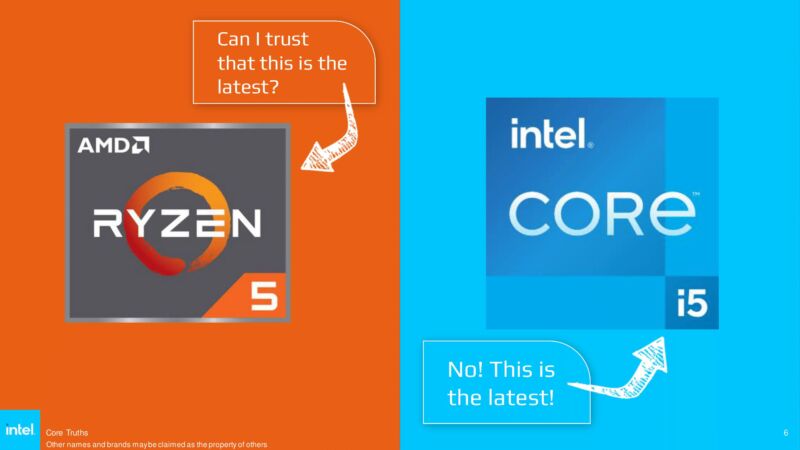
AMD changed the way it numbers its Ryzen laptop processors last year, switching to a new system that simultaneously provides more concrete information than the old one while also partially obfuscating the exact age of the various CPU and GPU architectures being mixed-and-matched.
For instance, a knowledgeable buyer can look at the “3” in the Ryzen 5 7530U processor and determine that it uses an older Zen 3-based CPU core. But a less-knowledgeable buyer could be forgiven for looking at the “7000” part and assuming that the chip is significantly newer and better than 2021’s Ryzen 5600U, when in reality the two are substantially identical.
Intel came out swinging against this naming scheme in a confrontational slide deck this week—now deleted, but preserved for posterity by VideoCardz—where it accuses AMD of selling “snake oil” by using older processor architectures in ostensibly “new” chips.
The “Core Truths” deck takes particular issue with the Ryzen 7020 series, released in late 2022 and into 2023 but using Zen 2-based CPU cores that date back to mid-2019. Intel argues, not inaccurately, that a 13th-generation Core i5-1335U chip can perform much better than a Ryzen 5 7520U, despite both being marketed as recent releases.

Take that i5-1335U. Intel is right that it uses the company’s most recent CPU architecture, codenamed Raptor Lake (the next-gen Meteor Lake is around the corner, but it’s not here yet). What Intel neglects to mention is that, in most cases, Raptor Lake is merely a new name for the Alder Lake architecture used in 12th-generation processors. The Core i5-1355U is nearly identical to the Core i5-1255U, aside from some mild clock speed boosts to the CPU and GPU.

“Rebranding old technology to make it seem newer” is a trick that practically all big chipmakers have resorted to at one time, and Intel has a particularly rich history with it. The mid-to-late-2010s manufacturing problems that lost Intel its chipmaking technology lead also resulted in a whopping five generations of chips that all used some variation of the same Skylake-based CPU and GPU architecture. Performance kept increasing throughout this era as Intel bumped up clock speeds and added more cores, but these were much more gradual improvements than what we had gotten used to in the mid-2000s into the early 2010s.
And Intel’s technology reuse isn’t all in its past, either. Its 13th-generation desktop GPUs only improved on the 12th-generation models in small ways, and the 14th-generation desktop chips are nearly identical to the 13th generation. Intel used the same basic Iris Xe integrated GPUs in three successive generations of laptop chips without making any improvements of note.
There’s nothing inherently wrong with a company reusing its technology, as boring as it sometimes is for reviewers and enthusiasts to have to take so many looks at so many incremental iterations on the same basic tech. Intel needs to serve its PC-making partners, and those partners demand new chips so they can keep making and selling new things; the market demands newness, regardless of whether these products are truly new or simply “new” in quotation marks. But for Intel to complain about AMD’s practices here feels particularly unearned and petty.
And of all the AMD processors to complain about, the Ryzen 7020 series isn’t even the worst offender, given that it pairs the old Zen 2 architecture with a newer manufacturing process and an RDNA 2-based integrated GPU—its CPU cores are based on an older design, but there’s a lot about the processor that actually is updated.
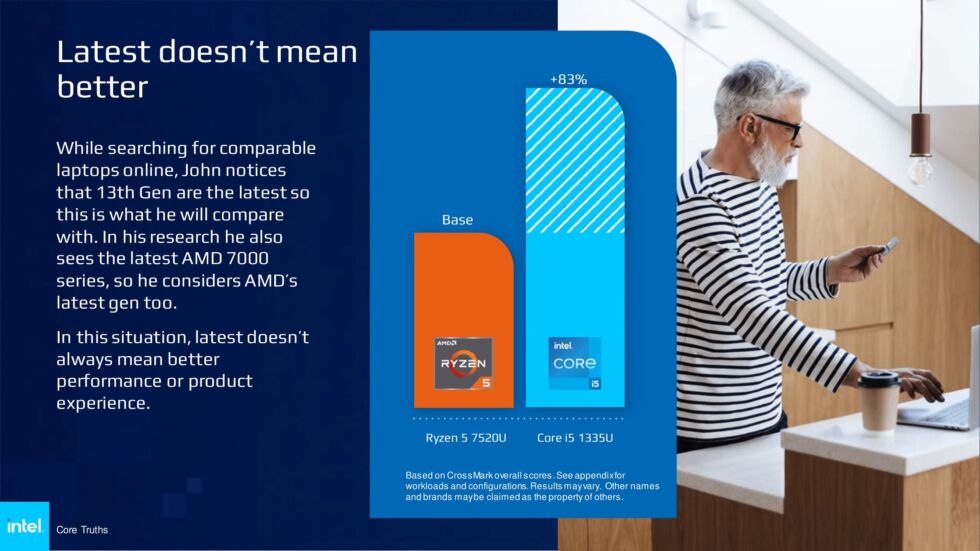
As Intel points out, mixing new technology in with the old doesn’t necessarily make the 7520U’s CPU competitive (both the 7520U and i5-1335U appear in laptops that start in the $400–$500 range on many retail sites, and Intel’s chip will thoroughly outrun AMD’s, especially in multi-threaded tasks). I wish that AMD would commit to refreshing its laptop chip range in a more consistent way since it would be less confusing and keep people from ending up with what is a more-or-less 5-year-old processor performance in a brand-new laptop.But if Intel has a problem with repackaging old technology and selling it as new, the company should consider looking inward before complaining about what others are doing. To gripe about AMD’s practices just weeks after releasing the barely updated 14th-generation Core desktop processors—maybe Intel should move out of its glass house before it starts throwing rocks.
As reported by ANandTech,
Intel has released their first mobile processors based on their highly anticipated Meteor Lake platform, the Core Ultra H and the Core Ultra U series. Available today, the Ultra Core H series has four SKUs, including two Ultra 7 16 core (6P+8E+2LP) chips and two 14 core (4P+8E+2LP) Ultra 5 chips. All run at a base TDP of 28 W, with a maximum turbo TDP of up to 115 W. The Core Ultra-H series is designed for ultra-portable notebooks but offers more performance in both computing and graphics within a slimline package.
Also announced is the Intel Core Ultra U-series, which includes four 15/57 W (base/turbo) SKUs, with two Core Ultra 7 and two Core Ultra 5 SKUs, and all coming with a variance in P, E-core and Intel’s latest integrated Arc Xe graphics frequencies. All of Intel’s announced Core Ultra U-series processors for mobile feature 10 CPU cores, with two Performance cores and eight Efficiency cores, making them ideal for lower-powered and ultra-thin notebooks.
The launch of Intel’s tile-based Meteor Lake SoC marks the first step in a series of power-efficient and AI-focused chips on Intel 4 for the mobile market, which is ultimately designed to cater to the growing need to utilize AI inferencing on-chip. Both the Intel Core Ultra H and U families of chips include two new Low Power Island (LP-E) cores for low intensity workloads, with two Neural Compute Engines within the Intel AI NPU designed to tackle generative AI inferencing.
Quickly recapping the Meteor Lake SoC architecture, it is essentially four interconnected tiles, including a compute, graphics, SoC, and an I/O tile. Within each of the tiles are a host of new advancements, including the Redwood Cove Performance (P) cores and Crestmont Efficiency (E) cores housed within the compute tile. On top of this, Intel also has a special variant of the E-core, called the Low Power Island or LP-E core, which is integrated into the SoC tile and is designed to tackle low-intensity workloads. Notably, because the SoC tile is essentially always active, the LP-E core is very cheap to use from an energy standpoint compared to powering up the CPU tile.

Meteor Lake is an upgrade and a significant architectural shift for Intel, moving away from traditional monolithic designs to a chiplet-based approach. This shift, leveraging Intel’s Foveros 3D packaging technology, introduces 3D chip stacking to overcome the limitations of 2D chip layouts. Like other shifts we’ve seen towards using chiplets, the architecture’s focus on disaggregation, power efficiency, and flexible silicon gives Intel new options for assembling CPUs out of individual blocks.
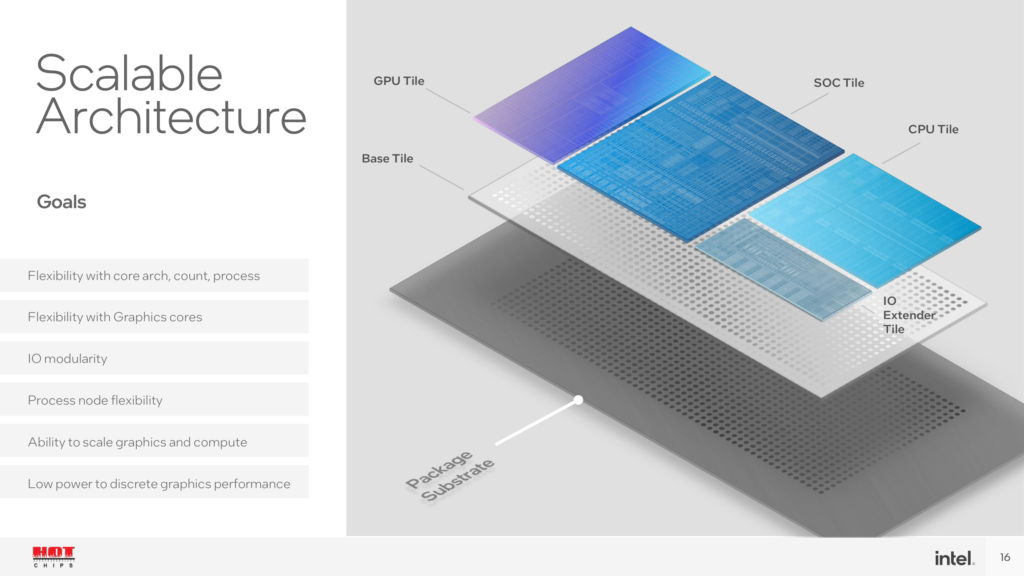
The architecture’s modular design facilitates scalable power management, which can be optimized, allowing each tile to operate independently, thereby maximizing performance and energy efficiency. This disaggregation also enables Intel to use different silicon processes for each tile, offering flexibility and cost savings in manufacturing. Meteor Lake’s use of Foveros packaging and low-power, low-distance die-to-die interconnects marks a departure from the Multi-Chip Packaging (MCP) used in the previous Raptor Lake mobile chips, allowing for more optimized power usage and chip customization.
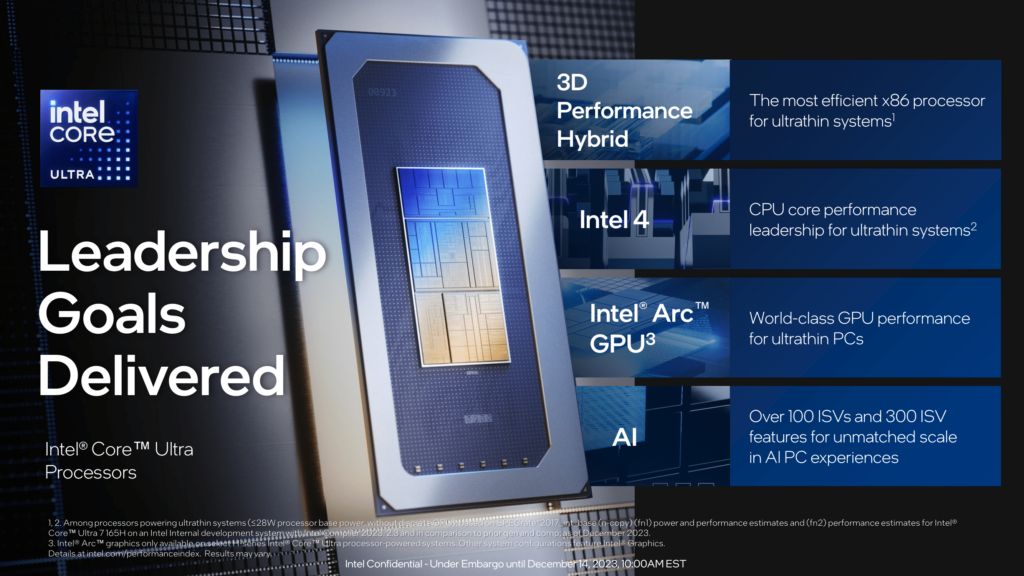
Offering four differently built yet highly functional tiles, Intel’s Meteor Lake looks to increase customizations of their notebook SKUs in the future. Offering a tile solution enables Intel to amalgamate a variety of different engines, blocks, and tiles into one chip. Using their Foveros packaging technology also allows Intel to build chips differently, and more importantly, it means they aren’t limited to one specific manufacturing process – a hedge against problems with any one fab/node. Even in the present Core Ultra U and H series chips Intel is announcing today, the manufacturing choice for each of the tiles differs slightly, with the compute tile built on Intel 4 node, the graphics tile with Arc Xe graphics is built on TSMC’s N5 node, and the SoC and I/O tiles are built using TSMC’s N6 process. This flexibility means Intel can implement new technologies from different process nodes, tapping the benefits of any given node’s specialty (e.g. frequency or density) and not having to produce (and yield) an entire chip on a leading-edge process.
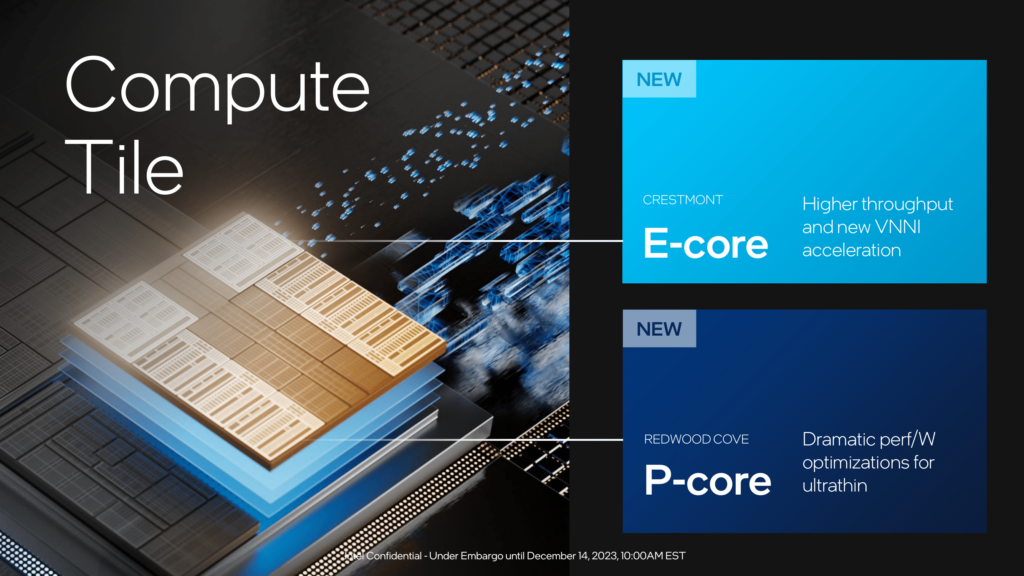
Taking a quick look at the underlying architecture, on the compute tile of the Ultra Core series in the first iteration of Meteor Lake, Intel is using two new CPU architectures within the heterogeneous design. Intel’s Meteor Lake compute tile is built using the Intel 4 node, and the process offers 2x the area scaling for the high-performance logic libraries compared to the previous Intel 7 node. The latest Performance cores are called Redwood Cove, which Intel claims brings new benefits over the previous Golden Cove P-core, including better per-watt performance efficiency, improved feedback through Intel Thread Director within Windows 11, more bandwidth, and improved performance monitoring capabilities. All of these improvements combined are designed to provide enhanced feedback to Thread Director to help optimize core performance and direct workloads to the right cores.
Notably, however, Intel hasn’t said anything about Redwood Cove’s IPC. Reading between the lines, we are left with the distinct impression that Redwood Cove’s IPC is similar (if not identical to) Golden Cove’s. And if that’s the case, it means Intel won’t be moving the needle on single threaded performance in this generation – at least, not in TDP-unconstrained scenarios. In fact, the peak P-core clockspeeds for Core Ultra (Meteor Lake) chips are lower than 13th Gen Core Mobile (Raptor Lake) chips – 5.1GHz vs. 5.4GHz – so it’s entirely plausible that some Core Ultra chips could lose in single-threaded CPU benchmarks to 13th Gen Core chips. All of which is to say that while Intel should still pick up some real-world performance here due to the energy efficiency improvements, Redwood Cove is more of a side-grade in terms of architecture.
Intel’s efficiency cores, on the other hand, should deliver a major improvement. Intel is using their Crestmont cores for the efficiency cores, which Intel claims bring IPC gains over their 13th Gen Raptor Lake E-cores, as well as AI acceleration optimizations in VNNI and ISA, as well as enhanced feedback to Intel Thread Director. For low-intensive workloads, Intel includes two new Low Power Island (LP-E) cores on each of the announced SKUs housed within the SoC tile and allows light workloads to be offloaded onto these cores to enhance overall power efficiency. Intel Thread Director with Windows 11 is a key component in ensuring the right workloads go onto the right cores for the best performance and power efficiency levels.
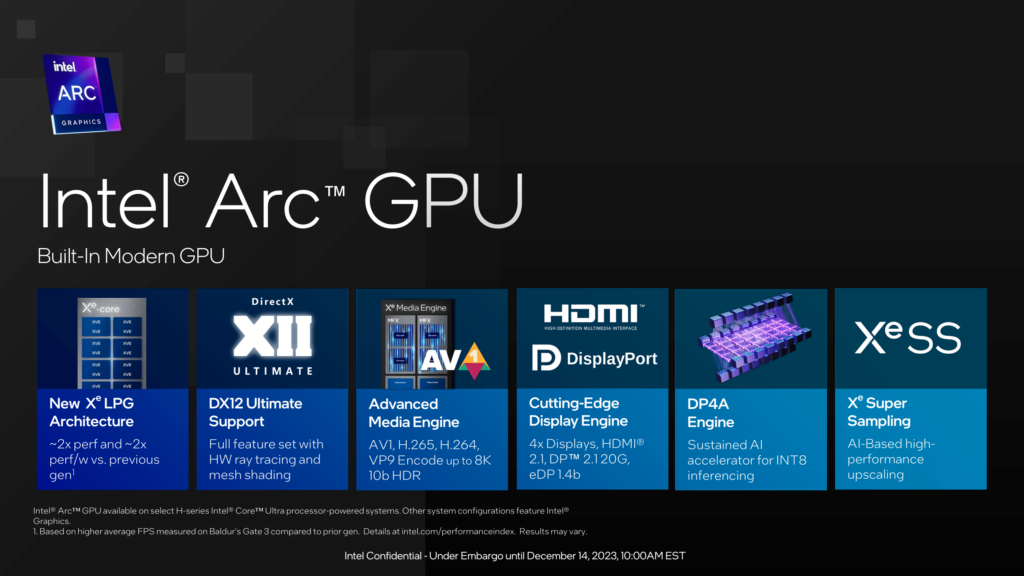
Another key component (or tile) within the heterogeneous Meteor Lake SoC design is an upgrade to Intel’s Arc graphics architecture. Built on TSMC’s N5 node, the graphics core of choice is the Arc Xe-LPG core, which is a derivative of Intel’s discrete Xe-HPG GPU architecture. The GPU tile is comprised of 16 Vector Engines with a 256-bit bus width and 192 KB of shared L1 cache per core. Each Vector Engine can perform 16 FP32 and 32 FP16 operations per clock, along with a shared FP64 execution port capable of 64 INT8 operations per clock. Also featured is a dedicated FP64 unit, which is new compared to Raptor Lake (13th Gen) and has pairs of vector engines operating in lockstep for improved efficiency. Notably, this architecture does not include Intel’s matrix engines (XMX), so while Intel can run AI tasks on the GPU, it doesn’t have quite the same punch as on their desktop hardware.
For Meteor Lake, Intel has opted to disaggregate the Xe Media Engine from the graphics tile and implanted it within the SoC tile, which is built on TSMC’s N6 node. The Xe Media Engine includes two multi-format codecs (MFX), which are designed to encode and decode but do so off of the GPU to improve power efficiency. Meteor Lake supports a wide variety of codecs, including AV1, HEVC, AVC, and VP9, with capabilities including up to 8K60 HDR decoding. The Xe Media Engine is also equipped to handle up to 8K 10-bit and HDR encoding.
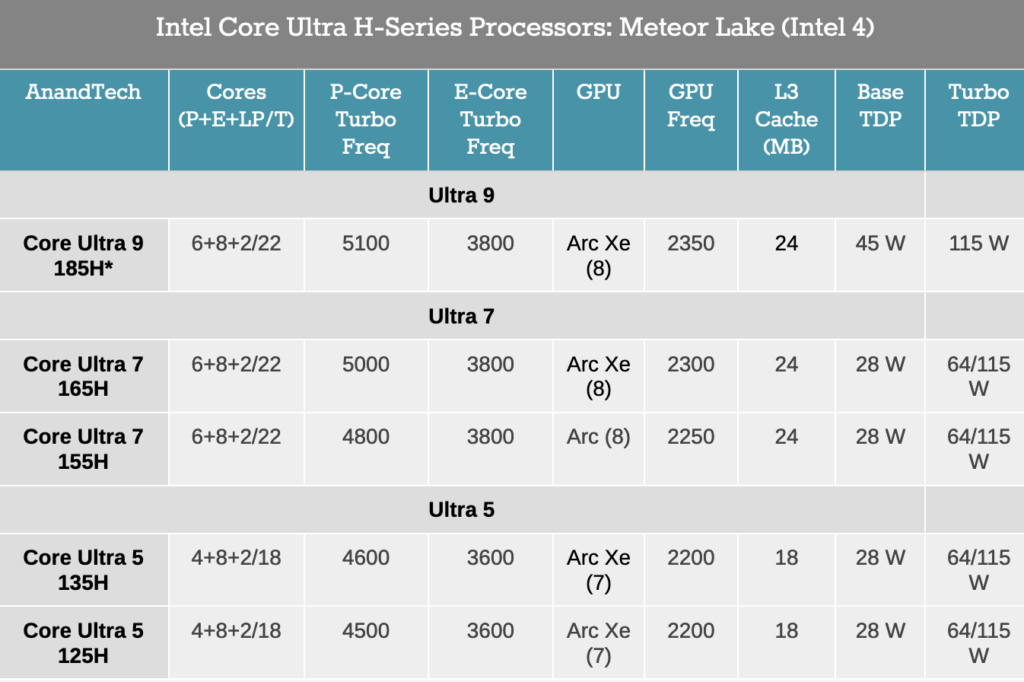
The Intel Core Ultra H and U-series processors are available today, with over 35 OEMs offering different models, including Acer, ASUS, Dell, HP, Lenovo, and MSI. The only SKUs not launching today include the Intel Core Ultra 9 185H, Core Ultra 7 164U, and Core Ultra 5 134U, which are expected to launch sometime in Q1 2024. At the time of writing, no OEMs have reached out to us with models, and pricing on each part remains unknown.
More information at ANandtech.com
As reported by Vice,
Governments are spying on U.S. smartphone users through the push notifications that they receive from apps, Senator Ron Wyden wrote in a letter to the Department of Justice on Wednesday and Apple confirmed.
Wyden wrote that the federal government had restricted Apple and other companies’ ability to share information about this process. The Senator’s office “received a tip” last year that “government agencies in foreign countries were demanding smartphone ‘push’ notification records from Google and Apple,” Wyden, a Democratic senator from Oregon, wrote in the letter to Attorney General Merrick Garland. “My staff have been investigating this tip for the past year, which included contacting Apple and Google. In response to that query, the companies told my staff that information about this practice is restricted from public release by the government.”
Apple confirmed in a statement to Reuters on Wednesday that, “In this case, the federal government prohibited us from sharing any information. Now that this method has become public we are updating our transparency reporting to detail these kinds of requests.”
The process by which push notifications are generated requires the phone company to serve as a “digital post office,” Wyden wrote. Push notifications are sent through Apple and Google’s servers, which means that the companies “serve as intermediaries in the transmission process,” and can therefore be made to hand over information to governments that request it.
According to Wyden’s letter, the information that can be gleaned from push notification requests is mostly metadata. This includes information “detailing which app received a notification and when, as well as the phone and associated Apple or Google account to which that notification was intended to be delivered,” Wyden wrote. In some cases, requesters may even receive unencrypted content such as the text that was delivered in the notification.
The senator said that companies can therefore “be secretly compelled by governments to hand over this information.”
An unnamed source confirmed to Reuters that both foreign and U.S. government agencies had been asking the companies for push notification data, for example to tie anonymous users of messaging apps to specific accounts. They did not say which government agencies had participated in this, or for how long.
Apple advises its developers to encrypt any sensitive data sent through a push notification, but does not require this practice.
An Apple spokesperson told Motherboard that the company was “committed to transparency” and had “long been a supporter of efforts to ensure that providers are able to disclose as much information as possible to their users.” The spokesperson said that Apple had updated its law enforcement guidelines and would begin to break out the requests for push notifications that it had received in its next transparency report.
Apple’s new law enforcement guidelines now include a section on the company’s push notification service. “The Apple ID associated with a registered APNs [Apple Push Notification service] token may be obtained with a subpoena or greater legal process,” the document states.
A Google spokesperson said in an emailed statement to Motherboard: “We were the first major company to publish a public transparency report sharing the number and types of government requests for user data we receive, including the requests referred to by Senator Wyden. We share the Senator’s commitment to keeping users informed about these requests.” The spokesperson did not clarify any restrictions on publishing information relating to requests for push notification data.
“Apple and Google should be permitted to be transparent about the legal demands they receive, particularly from foreign governments,” Wyden wrote. “These companies should be permitted to generally reveal whether they have been compelled to facilitate this surveillance practice, to publish aggregate statistics about the number of demands they receive, and unless temporarily gagged by a court, to notify specific customers about demands for their data. I would ask that the DOJ repeal or modify any policies that impede this transparency.”
As reported by LaptopMag,
This week, Google’s December Feature Drop for Pixel devices was accompanied by a wealth of content showcasing the brand’s latest multimodal AI, Gemini. In a series of videos highlighting the software’s key and unique features, the brightest minds from Google HQ wowed us with a series of bold claims and presentations.
Enter a slow fade-in from black mixed with “generic-slow-build-piano-music.mp3” as Google CEOs Sundar Pichai and Demis Hassabis talk about their drives and passion for the Gemini project like it was an American Idol audition vignette for the brainiest boyband imaginable.
What followed was a series of talking head moments with the Googleplex’s top brass hyping up the moment as if they’d just figured out how to hardcode the return of the Messiah. Unlike most AI models, Gemini is capable of deciphering a mix of text, code, and media all at once to understand the wider context of what it is tasked with achieving.
For example, in one demonstration Gemini was pre-prompted by text to act as a kitchen assistant, and then a voice recording was added to the prompt where a user asked for instructions on how to begin making a veggie omelet using the available ingredients. Finally, a picture of the ingredients was included before Gemini was asked to generate a response.
In the video, you’ll be able to see that Gemini’s reply adopted the role of the kitchen assistant, observed the available ingredients, and then delivered the first step in veggie omelet preparation in the form of a voice note. Impressive stuff, to be sure. Especially when the user was able to show Gemini an updated picture of their omelet in process and ask Gemini how it was going, with the AI picking up that the dish was ready to be cooked on the other side.
Following the release of the “hands-on” video, Bloomberg Opinion columnist Parmy Olsen was quick to point out the small print included in the video description, reading: “For the purposes of this demo, latency has been reduced and Gemini outputs have been shortened for brevity.”
However, according to Bloomberg, when asked for comment Google expanded on this disclaimer further — revealing that the demo didn’t happen in real-time, nor did it include spoken prompts.
In fact, a Google spokesperson revealed that the video was made by using “still image frames from the footage, and prompting via text.” In essence, the very same interaction as was shown in the previous veggie omelet example.
While ultimately still impressive, the edited video does somewhat misrepresent the experience of using Gemini — painting it as a far more capable tool than it currently is.
As reported by CNBC,
A federal court jury decided late Monday that Google’s Android app store, Google Play, uses anti-competitive practices that hurt consumers and software developers.
The verdict is a significant win for Epic Games and its CEO, Tim Sweeney, which have been fighting against mobile app stores and their fees since 2020 — including an unsuccessful challenge to Apple’s App Store rules which is currently being appealed to the Supreme Court.
Sweeney attributed the win to revelations during the trial that Google had allegedly deleted or failed to keep records such as chats about its secretive deals with app makers. He also noted that it had been a jury trial, while the Apple case was decided by a judge.
“The brazenness of Google executives violating the law, and then deleting all of the records of violating the law,” Sweeney said in an interview with CNBC. “That was really astonishing. This is very much not a normal court case, you don’t expect a trillion-dollar corporation to operate the way Google operated.”
Epic Games originally sued Google in 2020, alleging it uses its dominant position as the developer of Android to strike deals with handset makers and collect excess fees from consumers. Google collects between 15% and 30% for all digital purchases made through its storefront. Epic tried to bypass those fees by charging users directly for purchases in the popular game Fortnite; Google then booted the game out of its store, spurring the lawsuit.
The decision could give app makers a bigger revenue share of the digital app market, which is currently dominated by Google and Apple, and is worth about $200 billion per year. The loss for Google could also empower other antitrust-based challenges to the search giant’s business, including a similar case brought by the Department of Justice.
Monday’s unanimous verdict came after a four-week trial in federal court in California. The jury found that Google acquired and maintained monopoly power in the Android app distribution market, as well as the in-app billing market for digital goods and services transactions.
The result is markedly different than Epic Games’ similar effort to change Apple’s App Store, in which which it lost 9 of 10 counts in 2021. Its only win was a judgment to suspend a rule about being able to email app customers. That ruling is currently being appealed to the Supreme Court.
One major difference was that Epic had a harder time finding documentation from inside Apple. Another is that Google’s Android allows software to be installed from the internet, a process called sideloading, while Apple bars it.
“The big difference between Apple and Google is Apple didn’t write anything down. And because they’re a big vertically integrated monopoly, they don’t do deals with developers and carriers to shut down competition, they just simply block at the technical level,” Sweeney said.
During the Google trial, Epic Games instead focused on whether Google locked up the app store market through deals with handset makers, and whether it scared users away from using Android’s sideloading functionality through security warnings.
It specifically called out secretive revenue-sharing contract deals with Samsung and Chinese handset makers, which these partners allegedly signed in exchange for supporting the Google Play Store on new devices. It also revealed that Google had entered into talks with Epic Games over an investment in the Fortnite maker.
U.S. District Judge James Donato will hold hearings in January to determine what changes Google will have to make.
Google might have to alter its Google Play Store rules, including opening up an option for billing and distribution outside of the store. Epic will push for lower fees, alternatives to Google Play and less scary warnings about installing software from the internet, Sweeney said. He added that Epic Games is not seeking monetary damages.
Sweeney is not optimistic that change will be immediate.
“If Google is obstructing a vertical remedy through appeals and isn’t offering an awesome deal,” Sweeney said, the company will not be on Google’s services.
Google said it will appeal the decision. Google previously reached settlements with consumers, state attorneys generals and Match Group over Google’s app store policies.
“We plan to challenge the verdict,” Wilson White, Google vice president for government affairs and public policy, said in a statement. “Android and Google Play provide more choice and openness than any other major mobile platform. The trial made clear that we compete fiercely with Apple and its App Store, as well as app stores on Android devices and gaming consoles. We will continue to defend the Android business model and remain deeply committed to our users, partners, and the broader Android ecosystem.”
Sweeney does hope that some of Google’s deals revealed during the trial could give its partners leverage in negotiations. On Tuesday, Wells Fargo analysts cited the risk of partners striking harder bargains in exchange for carrying Google’s app store or using its billing system.
However, investors don’t seem to be particularly worried that the result of this trial will threaten Google’s app business, which could amount to about a total of $38.5 billion in annual revenue this year, according to an estimate from Wells Fargo. Google stock fell less than 1% during trading Tuesday.

